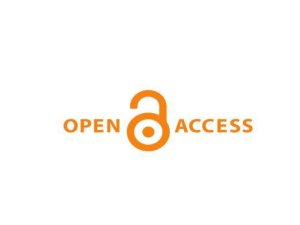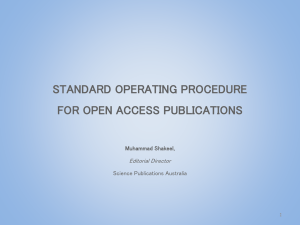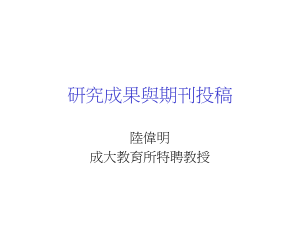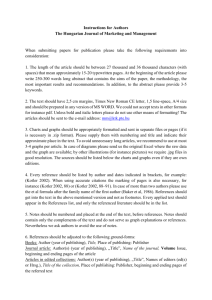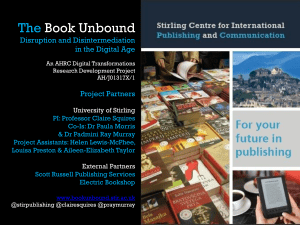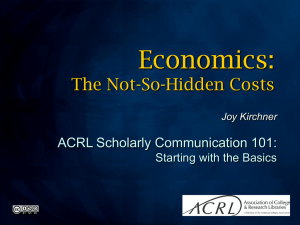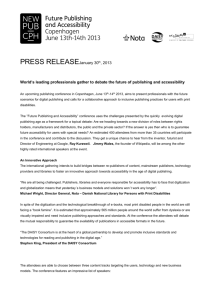Prolegomena to any future e
advertisement
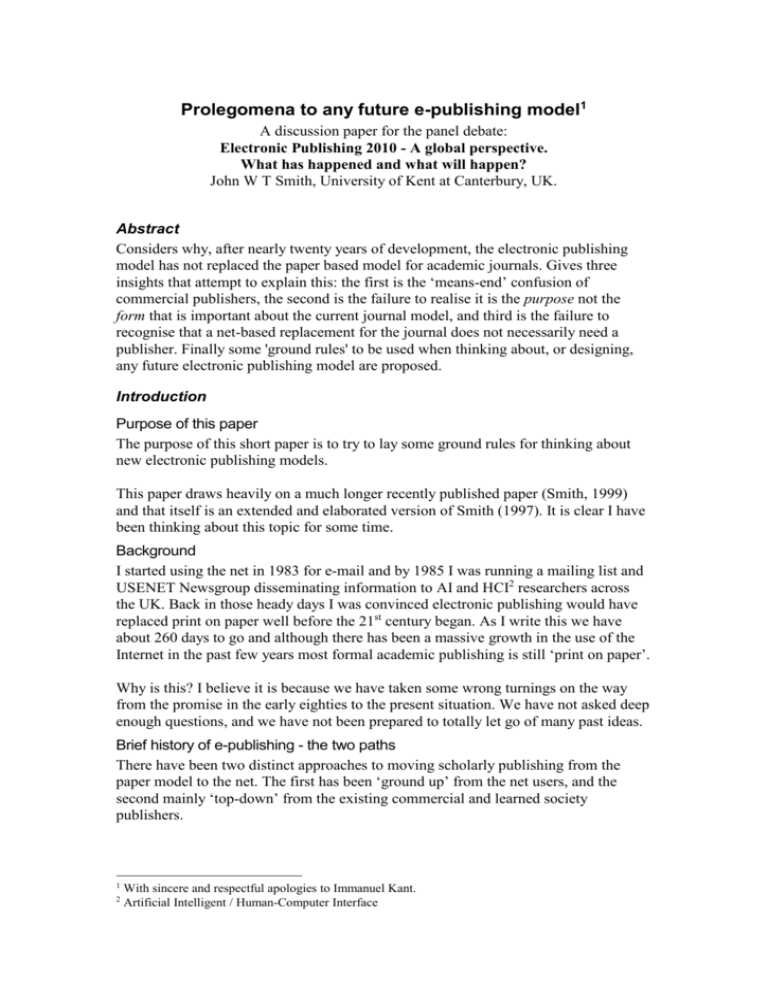
Prolegomena to any future e-publishing model1 A discussion paper for the panel debate: Electronic Publishing 2010 - A global perspective. What has happened and what will happen? John W T Smith, University of Kent at Canterbury, UK. Abstract Considers why, after nearly twenty years of development, the electronic publishing model has not replaced the paper based model for academic journals. Gives three insights that attempt to explain this: the first is the ‘means-end’ confusion of commercial publishers, the second is the failure to realise it is the purpose not the form that is important about the current journal model, and third is the failure to recognise that a net-based replacement for the journal does not necessarily need a publisher. Finally some 'ground rules' to be used when thinking about, or designing, any future electronic publishing model are proposed. Introduction Purpose of this paper The purpose of this short paper is to try to lay some ground rules for thinking about new electronic publishing models. This paper draws heavily on a much longer recently published paper (Smith, 1999) and that itself is an extended and elaborated version of Smith (1997). It is clear I have been thinking about this topic for some time. Background I started using the net in 1983 for e-mail and by 1985 I was running a mailing list and USENET Newsgroup disseminating information to AI and HCI2 researchers across the UK. Back in those heady days I was convinced electronic publishing would have replaced print on paper well before the 21st century began. As I write this we have about 260 days to go and although there has been a massive growth in the use of the Internet in the past few years most formal academic publishing is still ‘print on paper’. Why is this? I believe it is because we have taken some wrong turnings on the way from the promise in the early eighties to the present situation. We have not asked deep enough questions, and we have not been prepared to totally let go of many past ideas. Brief history of e-publishing - the two paths There have been two distinct approaches to moving scholarly publishing from the paper model to the net. The first has been ‘ground up’ from the net users, and the second mainly ‘top-down’ from the existing commercial and learned society publishers. 1 2 With sincere and respectful apologies to Immanuel Kant. Artificial Intelligent / Human-Computer Interface The Users’ approach The approach of the users has been to adapt available tools to provide generalised communication systems of use to the academic community. These were built using email, FTP, USENET Newsgroups, etc, and now they use the Web with indexes and search engines. Many of the original ides came from ‘techies’ who built systems (like USENET) to solve their own problems but the information specialists and the netaware academics quickly spotted the possibilities for information dissemination and peer communication. None of these innovations came from the commercial users. It was this band of enthusiasts who gave us such things as moderated mailing lists and newsgroups which improved the ‘signal to noise’ of these proto-publishing systems a form of simple ‘peer review’. From these beginnings came important systems like the Physics E-print Archive, (Ginsparg, 1994) and real e-journals like EJournal (Jennings, 1991). It was also these pioneers who experimented with new ways to provide peer review on the net. For example consensus journals and other techniques to decide the worth of a published item (Harnad, 1990, 1996, Nadasdy, 1997). However, it must be said that although many new ideas have been tried by these ‘bottom up’ developers there has been a reluctance on the part of many otherwise innovative users to totally abandon the idea of the journal. Some even still use the issue to define units of their publications even though it is generally agree there is no real need for this unit on the net. Old habits die hard! The users’ approach leads to publishing models that make better use of the capabilities of the net but usually do not have the formal structure required for the solid, trustworthy transfer of organised knowledge. Sometimes the models used have been adapted to support such features as peer review or other forms of quality control but this often appears as if it has been ‘bolted on’ afterwards rather than being built in to the original design. The commercial publishers’ approach The approach of the commercial and learned society publishers has been mostly to mimic the look and feel of paper based journals, in most cases right down to the page appearance and layout. In the main they appear to have spent far more effort trying to think of techniques of charging for access to this material, and preventing non-payers from using it, than they have thinking about how they could provide a better service. The commercial publishers’ approach limits the capabilities of the net as a knowledge transfer medium by forcing on it concepts that make no sense in the network world. Because most have simply transferred a paper journal (or journals) to the net we still have the continuing existence of the page and the issue in a medium where such concepts make no sense. At a deeper level this approach also transfers to the net many of the flaws of the paper based model which many of us had hoped would disappear with true e-publishing. We still have the ideas like subscriptions that rise year on year above inflation, and that authors must give up copyright in their work in order to be published. Finally, at an even deeper level, the centrist approach (with the publisher at the centre) of the current model is at odds with the basically distributed model of the net. Wrong turnings - or the Three Insights From my brief analysis above it seems clear that neither the users’ nor the publishers’ approach is likely to lead to an e-publishing model that fully replaces the traditional print on paper journal in a way that makes best use of the capabilities of the net. Neither approach attempts to solve some of the problems of the current model - this should be possible in this completely new medium. Where have we gone wrong? My thinking on this has lead me to three insights3. The first insight - the ‘means-end’ confusion The commercial publishers (and many others who publish on the net) have set out to mimic or replicate the existing paper based journal model without asking the fundamental question ‘Why do we have journals - what are they for?’. By not doing so they have confused the current means, the paper journal, with the real end, scholarly communication and recognition. Much effort and money has been spent on finding ways to exactly replicate the page and the ‘look and feel’ of a particular journal - which is completely immaterial for the purpose of the journal which is to communicate information and knowledge between its users (authors and readers). By making this simple mistake they have never asked if there might be other ways of achieving this end and have carried on down a path that I believe is effectively a deadend. The second insight - a lesson from the past However we must not simply turn our backs on the paper based journal or we are in danger of ‘throwing the baby out with the bath water’. The journal has existed as the main form of formal academic publishing for centuries. The fact that it has maintained both its place and its basic structure for so long implies it must be doing something right, i.e., it must be playing a real role (or roles) in the academic world. It follows from this that any replacement must therefore play the same roles or, to rephrase it more clearly, it must satisfy the same needs. To apply this insight the first move therefore is to decide what roles the journal plays (or what needs it satisfies)4. The main roles These are the roles most users would say are played by the journal in its current form. Editorial - The most obvious role of the journal is the selection of material. This is entirely subject related. There may also be some element of quality control at this point but it is basic. The editors are just deciding if the item is worth the next step of passing to the referees for detailed consideration. Quality control (Content) - This is the part played by the referees, the famous (or infamous) ‘peer review’ system. It is not all negative - often comments passed back from the referees can improve the item and they might even improve the research by providing another line of thought for the researcher. 3 In some cases others have had these insights before me but those I know of did not draw the same conclusions. 4 I am not the first to take this approach. Line (1992) did a similar analysis for different reasons but his basic analysis agrees with mine. Savenije (1997) argues an opening case similar to mine but his analysis of the publisher/journal roles is too simplified. Quality control (Form) - The copy editing and page design, etc, that make a journal look professional. Obviously a well designed page with clear tables, high quality pictures, etc, does help to convey the information to the reader. This work can ensure the information present is clear to the reader but it does not add to the informational content. Conferring recognition of work done - In terms of importance this ranks first from the point of view of some authors though for others it is the dissemination of the information that is most important. It is because of this role that journals are considered to have a rank of importance. The highest ranking journals are not always those that have the largest circulation. It may be more related to standards set by the editorial board and the referees plus the ‘popularity’ of the journal, i.e., how many papers it attracts - the more the editors have to choose from the more selective they and the referees can (or have to) be. This ranking is effectively ‘assigned’ by the community - by this I mean it cannot be bought by producing a particularly attractive journal or selling thousands of copies. Marketing (or making aware) - Marketing of the journal to possible readers and other customers, e.g. libraries. Delivering/disseminating - The delivery of the information (or in the case of the paper journal the carrier) to the purchaser or reader. The ‘hidden’ roles In addition to the obvious roles played by the journal it also has hidden or nonobvious roles which are nevertheless important to the academic research community. Subject defining - The editorial board of a journal helps to define the subject it serves. It does this in two ways: Directly - through editorials commenting on current work or by invited review papers. Indirectly - through the editorial decisions made, i.e. the papers chosen for inclusion or exclusion. Community defining - Again, depending on the subject area, a journal may help define a research community through its readership. This is more likely to be true of emerging research areas. Note: I feel this is a neglected role of the journal. There is a tendency by some proponents of net publishing to promote the idea of ‘personalising’ information. They suggest we should we move to a database model where items are retrieved on demand based on a user profile or by some intelligent software agent analyzing the user’s needs. This ignores the community aspect of research where members of a research community have a common core background of knowledge. Those who proposed ‘personalising’ information provision have neglected to analyse all the roles played by the paper journal. Archiving (maintaining a record for posterity) - Strictly speaking it is not the role of the journal to archive the results of work done, but the physical objects that are the traditional journal are themselves archived, usually by the customers, mainly academic libraries. However this archiving role will need to be carried out by some organisation in any net based replacement for the journal. The third insight - these roles are often independent (or - there is no necessary need for the publisher) Reviewing the above ‘analysis’ of the roles of the journal is clear is that most of the activities involved are independent (e.g. quality control activities are not concerned with distribution), therefore there is no necessary need for some organisation to coordinate this activity (i.e., the publisher). This ‘insight’ is very important. Once it is clear the roles played by the journal are separable we do not need to only consider new publishing models that keep them together. The lack of this insight has been a fundamental barrier when thinking about how we can transfer the roles of the journal into the net-based world. It has been assumed by many considering the design of new publishing models that all the roles of the paper journal would need to be played by one organisation (the publisher?) in any net based replacement. Now we know this is not necessarily the case we can consider more distributed models - and distributed models map much more neatly onto the underlying structure of the net. One possible way to achieve this would be to have a collection of co-operating actors or agencies each of which plays one or more of the basic roles described above. One such model is described in detail in Smith (1999) This model separates the ‘netjournal’ into three parts: Filter - net based service known as a subject focal point. Evaluator - independent service which judges the quality of items Distributor - a server which makes items available This model also solves some of the problems of the paper model, eg, the scatter problem. It is important that new models should aim to solve some of the problems present in the current model. Further, any new model that claims to be a new paradigm must have this feature (Kuhn, 1970). Conclusion I have described some of the insights I have had when thinking about how to design new publishing models for formal academic publishing on the net. I am proposing that we should take the following as ground rules when thinking about new publishing models. Proposed ground rules The ‘let go’ rule - Let go completely of the superficial structure of the paper-based model The ‘purpose not form’ rule - Remember it is the purpose not the form of the old model that we need to consider in future designs The ‘fulfilling’ rule. Ensure any new model fulfills the essential roles (both main and hidden) that the old model fulfilled The ‘publisher not necessary’ rule - Remember that we do not need to duplicate the publisher role in a net-based model The ‘better match to the net environment’ rule - Look for models that map more neatly onto the underlying structure of the net, i.e., distributed, flexible models rather than rigid centrist models The ‘solve existing problems’ rule - Prefer models that solve some of the problems of the current model. References Ginsparg, P (1994) First Steps towards Electronic Research Communication, Computers in Physics, Vol. 8, No. 4, July/August 1994, pp. 390-396. Harnad, S (1990) Scholarly Skywriting and the Prepublication Continuum of Scientific Inquiry, Psychological Science, Vol. 1 (November 1990), pp342-344. Harnad, S (1996) Implementing Peer Review on the Net: Scientific Quality Control in Scholarly Electronic Journals. In: Peek, R. & Newby, G. (Eds.) Scholarly Publication: The Electronic Frontier: MIT Press 1996. (Available in e-form at http://cogsci.soton.ac.uk/~harnad/Papers/Harnad/harnad96.peer.review.html) Jennings, E M. (1991) EJournal: An Account of the First Two Years, The PublicAccess Computer Systems Review, Vol. 2, No. 1, 1991 (E-version available at: http://info.lib.uh.edu/pr/v2/n1/jennings.2n1) Kuhn, Thomas S (1970) The Structure of Scientific Revolutions, 2nd edition, University of Chicago Press 1970. Line, M (1992) The Publication and Availability of Scientific and Technical Papers: An Analysis of Requirements and the Suitability of Different Means of Meeting Them, Journal of Documentation, Vol. 48, No. 2, June 1992, pp 201-219 Nadasdy, Z (1997) Electronic Journal of Cognitive and Brain Sciences: A Truly AllElectronic Journal: Let Democracy Replace Peer Review, The Journal of Electronic Publishing, Vol. 3, No. 1, 1997. (E-version available at: http://www.press.umich.edu:80/jep/03-01/EJCBS.html) Savenije, B (1997) New competitors for the publishers: the cobbler and his last. Electronic Library, Vol 15 No 6, December 1997. pp 431-435. Smith, J W T (1997) The Deconstructed Journal, In Electronic Publishing '97 - New Models and Opportunities, Proceedings of the ICCC/IFIP Conference on Electronic Publishing, 14-16 April 1997, University of Kent at Canterbury, UK, Edited by: Fytton Rowland and Jack Meadows, ICCC Press 1997, ISBN 1-891365-00-2. pp73-84 (E-version available at: http://www.ukc.ac.uk/library/ICCC/papers/deconjnl.htm) Smith, J W T (1999) The Deconstructed Journal - a new model for Academic Publishing, Learned Publishing, Vol.12, No.2, April 1999 In press. (E-version available at: http://www.ukc.ac.uk/library/papers/jwts/d-journal.htm)

